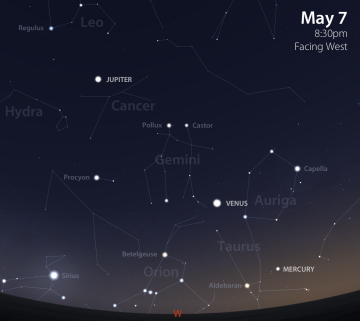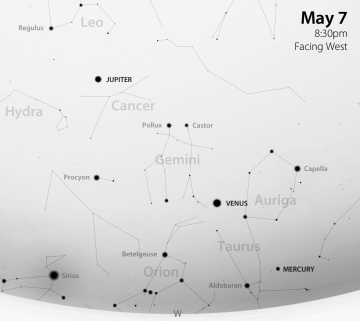Huestis: May’s Planet Parade for the Astronomy Enthusiast
Saturday, April 25, 2015
The significant snow cover that blanketed our local region this past winter is now just a bad memory (though it is highly likely some snow piles may still remain). Seagrave and Ladd observatories were closed for months, and even those astronomers who had their own telescopes and/or observatories seldom ventured out. When it wasn’t snowing or cloudy, many nights saw sub-zero temperatures. As the weather now continues to moderate, let’s hope the skies will finally permit astronomers of all levels to train their instruments on the heavens to reveal once again the beauty of the universe. And four planets will help to kick off what promises to be a productive observing season.
During the first few weeks of May you can catch a naked-eye view of Mercury. On May 1, if you have an unobstructed view towards the west-northwest, you will find our solar system’s closest planet to the Sun about ten degrees (a fist held at arm’s length provides this measurement) above the horizon after sunset. It will be just less than two degrees to the left of the Pleiades star cluster (Subaru symbol), and just about ten degrees to the right of the V-shaped Hyades cluster that forms the face of Taurus the Bull.
Each night Mercury will be found higher above the horizon, reaching its highest point on the 7th. Thereafter it will begin to sink towards the horizon. On the 19th a waxing crescent Moon will be above and to the left of Mercury. Throughout this favorable apparition try using a telescope if you have one to watch Mercury’s quickly changing phases.
GET THE LATEST BREAKING NEWS HERE -- SIGN UP FOR GOLOCAL FREE DAILY EBLASTAlso during the first week of May, on the morning of the 6th, we can view a meteor shower of particles shed by Halley’s Comet long ago. Unfortunately this shooting star display is best seen from the southern hemisphere. Locally we can usually expect no more than 10-15 swift and yellow Eta Aquarids per hour as they hit our upper atmosphere head-on at 41 miles per second. However, with a bright waning gibbous Moon (two days after full) prominent in the sky, those numbers will be significantly reduced.
Furthermore, Aquarius, the constellation from where the meteors appear to emanate, is not very prominent. For many casual stargazers it can be a little difficult to recognize even without bright moonlight. Aquarius will be about 12 degrees above the east-southeast horizon at the 4:00am hour. The shower’s radiant point is in the Water Urn asterism (looks like a Y-shaped group of stars). The best time to scan the sky for meteors will be between 2:00am and dawn’s early light.
Even non-astronomers must have noticed a bright celestial beacon high in the western sky after sunset. It’s our closest planetary neighbor Venus. Each night Venus will increase its height above the horizon. During the last week in May it will attain its highest elevation for this apparition. From the 20th through the 22nd a waxing crescent Moon will join Venus for a beautiful sky scene.
Venus goes through phases like Mercury, but the phase change occurs over a much longer period of time. During May, a telescope will show this cloud-enshrouded planet’s phase appearing like a first quarter moon. As the months progress, the phase will decrease until it looks like a thin crescent at the end of July. All the while, due to our respective orbits, the Earth and Venus will be moving closer together. So as the phase decreases, the apparent size of Venus will increase. Even a small telescope will reveal these changes over time. Every few weeks monitor Venus to see if you can follow the phase progression. Consider rendering what you observe with pad and pencil. What a novel idea!
Shifting your gaze up and to the east (left) of Venus one can find the largest planet in our solar system—Jupiter. This giant world is exciting to observe through any sized telescope. The primary bands and zones are easy to see, though the centuries old Great Red Spot is no longer very great nor as red as it once was. Jupiter’s four Galilean moons parade around the planet, providing many interesting events to observe. You might see a moon disappear into Jupiter’s shadow, or reappear from behind it. It’s also possible to observe the shadow of one of these moons as it transits (moves across) Jupiter’s cloud tops.
In fact, on Wednesday, May 20, from approximately 8:06 to 8:35pm EDT, a telescope will reveal the shadows of both Io and Callisto. A week later, on Wednesday, May 27, between approximately 10:00pm and 12:18am, the shadows of Io and Ganymede will be seen. At around 11:45pm, with Jupiter just ten degrees above the western horizon, these two shadows will appear to merge.
The most beautiful planet in our solar system is Saturn. It is noted for its exquisite system of rings. Without the rings this sixth planet from the Sun would be fairly boring, for its cloud bands are not as prominent as those of Jupiter. Saturn rises around 9:20pm on May 1, but you should wait until it rises higher into the sky before observing it with a telescope. Saturn is closest to the Earth on May 22 when it will be approximately 833,500,000 miles away.
Saturn is quite bright right now (though not as bright as Jupiter) because its rings are tilted towards us at an angle of about 24 degrees, therefore reflecting more sunlight. They will reach a maximum tilt of just over 25 degrees in 2017. While the rings are most striking, try to locate a few of Saturn’s brightest satellites. Titan, its largest, is even larger than the planet Mercury. Four to five additional moons of Saturn can also be seen with small telescopes.
Don’t pass up an opportunity to view any of the planets highlighted in this article. While the instruments at all the local observatories provide spectacular images of these distant worlds, if you have your own telescope I strongly recommend dragging them out and putting them to good use. It should be collecting light, not dust. Or simply step outside to enjoy the beauty of the night sky with just your naked eye. And by all means, please introduce your children to the heavens.
Throughout the year astronomers are available at Rhode Island’s fine observatories to share views of the cosmos during free public open nights. Seagrave Memorial Observatory in North Scituate is open to the public every clear Saturday night. Also, Ladd Observatory in Providence is open every clear Tuesday night. Frosty Drew Observatory in Charlestown is open every clear Friday night year-round. And don’t forget the Margaret M. Jacoby Observatory at the CCRI Knight Campus in Warwick is open every clear Wednesday night. Be sure to check all the websites for the public night schedules and opening times before visiting these facilities.
Keep your eyes to the skies.
Dave Huestis
Related Articles
- Huestis: Observing the Winter Circle
- Huestis: Reason for the Season(s)
- Huestis: Astronomical Events Determine Easter Observance
- Skywatching: A Busy Month for Astronomy Enthusiasts




